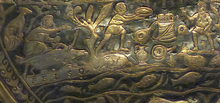Lake Balaton (Hungarian: [ˈbɒlɒton]) is a freshwater rift lake in the Transdanubian region of Hungary. It is the largest lake in Central Europe, and one of the region's foremost tourist destinations. The Zala River provides the largest inflow of water to the lake, and the canalized Sió is the only outflow.
The mountainous region of the northern shore is known both for its historic character and as a major wine region, while the flat southern shore is known for its resort towns. Balatonfüred and Hévíz developed early as resorts for the wealthy, but it was not until the late 19th century when landowners, ruined by Phylloxera attacking their grape vines, began building summer homes to rent out to the burgeoning middle class.
 Detail of a silver plate from the Seuso Treasure with the inscription PELSO (i.e., 'Balaton')
Detail of a silver plate from the Seuso Treasure with the inscription PELSO (i.e., 'Balaton')While a few settlements on Lake Balaton, including Balatonfüred and Hévíz, have long been resort centres for the Hungarian aristocracy, it was only in the late 19th century that the Hungarian middle class began to visit the lake.[1] The construction of railways in 1861 and 1909 increased tourism substantially, but the post-war boom of the 1950s was much larger.
By the turn of the 20th century, Balaton had become a center of research by Hungarian biologists, geologists, hydrologists, and other scientists, leading to the country's first biological research institute being built on its shore in 1927.[2]
The last major German offensive of World War II, Operation Spring Awakening, was conducted in the region of Lake Balaton in March 1945, being referred to as "the Lake Balaton Offensive" in many British histories of the war. The battle was a German attack by Sepp Dietrich's Sixth Panzer Army and the Hungarian Third Army between 6 and 16 March 1945, and in the end, resulted in a Red Army victory. Several Ilyushin Il-2 wrecks have been pulled out of the lake after having been shot down during the later months of the war.[3][4]
During the 1960s and 1970s, Balaton became a major tourist destination due to focused government efforts, causing the number of overnight guests in local hotels and campsites to increase from 700,000 in July 1965 to two million in July 1975. The number of weekend visitors to the region, including tens of thousands from Budapest, reached more than 600,000 by 1975.[2] It was visited by ordinary working Hungarians and especially for subsidised holiday excursions for labor union members.[citation needed] It also attracted many East Germans and other residents of the Eastern Bloc. West Germans could also visit, making Balaton a common meeting place for families and friends separated by the Berlin Wall until 1989.[5]



































Add new comment